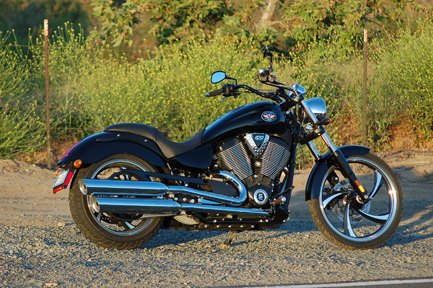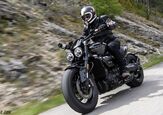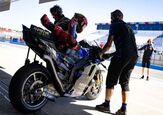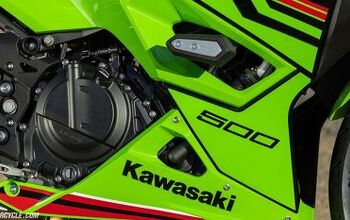2010 Victory Vegas 8-Ball Review - Motorcycle.com
When Polaris Industries launched its Victory Motorcycles line in 1999, the fledging motorcycle brand found itself behind the eight ball from the get-go. In terms of heritage and technological expertise, the young, budding company had a lot to make up on its competition. Victory’s original model, the V92, was a capable bike, but as a newbie and unproven model, it had its flaws.
A few years down the road, and buoyed by hard-earned research and development, Victory introduced a whole new platform called the Vegas. The 2003 Vegas was more than a roll of the dice, and the new model was all—and more—of what the V92 failed to deliver. The Vegas was solid, and the overall ride was on par with what the competition had taken years to develop for their cruiser models.
The revamped air/oil-cooled Freedom 100 engine proved superior to the original 92-incher, and the five-speed transmission was improved for smoother shifting. Victory—the word—was in sight, and sales for Victory motorcycles increased at a rather rapid rate for the ensuing years.
And as sales increased, the product line expanded. By the company’s 10th anniversary in 2009, Victory had added a bevy of new models, among them a bike with a specific styling treatment dedicated to America’s growing boulevard cruiser market. That bike was the Vegas 8-Ball, a blacked-out version of the successful and popular Vegas.
“Less is more” was the secret to the Vegas 8 Ball’s quick acceptance by Victory customers.
“Less is more” was the secret to the Vegas 8 Ball’s quick acceptance by Victory customers. Less chrome and fewer parts (no passenger footpegs, a more conventional headlight, and retention of the 100 engine and five-speed gearbox when the rest of the line received the new and slightly costlier 106 and six-speed) helped keep the 8 Ball’s MSRP down. By bouncing the bling out of the picture, the 8-Ball rolled in as one of the most affordable models in the Victory lineup.
But the Vegas 8-Ball was anything but cheap in terms of ride and performance. Indeed, during the past few years, the Vegas 8-Ball has been refined even more, and the 2010 model that was delivered to us for testing proved to be the best Vegas 8-Ball yet.
Start with the engine. Remember the expanded product line mentioned earlier? Among the notable developments was the all-new 2008 Vision touring machine, a bike that brought some innovative features to the motorcycle touring market. Some of the Vision’s new technology was also applied to the existing models such as the Vegas 8-Ball, and in this case the payoff was a better bike. Victory worked hard to refine the Vision’s engine so that touring riders would have a bike with a smoother, quieter ride. The same solutions were applied to the 8 Ball’s 100-cubic-inch engine, so the anti-backlash split gear on the clutch, quieter cam profiles, improved fuel-injection, and lower first gear that proved so successful on the Vision’s 106 were racked up with the 8-Ball’s 100.
The upgraded Freedom 100 engine also has a lower compression ratio of 8.7:1. The reduced compression allows for more ignition advance at lower rpm, the payoff being better bottom-end torque, smoother throttle response and resistance to detonation. Victory touts the 100’s specs at 85 horsepower and 106 ft.-lb. of torque, enough to compete with other cruisers in today’s market.
Release the clutch lever in first gear, and the 8-Ball easily chugs right off the line. Short-shift through the gears or screech that 50-degree V-Twin to redline, and either way you’ll be rewarded with smooth, seamless acceleration. Don’t bother looking for redline, though; this bike doesn’t have a tachometer. And if you happen to take the single-overhead-cam engine into the red zone, not to worry—the ignition rev limiter will let you know in a hurry that it’s time to shift to the next gear.
The Vegas 8-Ball’s ride and handling remain on the firm side. The conventional fork’s 5.1 inches of travel soaks up many of the bumps in the road, and the single-shock rear suspension (3.9 inches of travel) keeps the big Dunlop 180/55-18 rear tire planted on the pavement. Even with a 90/90-21 Dunlop front tire, initial turn-in for corners is relatively easy, with good feedback to the rider through the wide handlebar. However, the 180-mm rear tire behaves like most other fat rear tires will, giving the 8 Ball a slight “push” through the corners, requiring additional steering input to maintain the line.
Slowing and whoa’ing the 8-Ball is done through a pair of hydraulic disc brakes—one up front, one for the rear. The 4-piston front caliper squeezes onto a 300mm rotor, and hand-lever feedback is about what you expect from a single-disc package. Ditto for the 2-pot rear, and since you won’t be toting a passenger (remember, there are no passenger pegs on the 8-Ball, and there’s the issue about the solo seat, too…) you should have all the braking force you’ll need on the boulevard with this 638-pound (dry) cruiser.
You’ll be packing about as much fuel as you’ll probably need, too. That stylish gas tank holds 4.5 gallons of fuel. Figure on 40-45 mpg, so cruising range should outlast how long your butt can hold out on the small scalloped seat that sits you 26.5 inches off the deck. The seating position itself is somewhat cramped because the saddle places you closer to the pullback handlebar than preferred. A handlebar with slightly less setback might be a better fit.
In any case, once you settle into the saddle and place your waffle-stompers on the blacked-out forward foot controls, you’ll be styling down the boulevard, too. The black theme is carried out really well on this bike. The engine cases are black with machined or chromed highlights, the five-spoke wheels have machined edges for good contrast, and the chromed headlight and speedo stand out well against the black handlebar and accompanying switches and mirrors. Even the rear fender braces are blacked out. Truly, the Victory stylists gave serious thought to this bike’s overall finish.
Victory markets its 8-Ball series as a blank canvas upon which riders can modify it to make it their own. To sort the fact from the hype, we've accepted Victory's implied challenge to do a little styling and performance tuning of our own!
In this project bike series, we’ll explore the multitude of options offered by Victory’s accessory catalog and the aftermarket to modify our test bike to set it apart from all others. Our 8-Ball's VIN number, which ends in 666, gave us the inspiration for what we've dubbed "Evil 8."
We invite you to follow along in the coming weeks as we evolve Evil 8 into an even cooler street cruiser. We also intend to give it an edge in performance. So, aftermarket parts suppliers and vendors, rack ‘em up!
Related Reading
2010 Victory Motorcycles Lineup Preview
2010 Victory Vegas LE Review
2009 Victory Cory Ness Signature Jackpot Review
2009 Victory Vegas 8-Ball Review
Mainstream Chopper Shootout
2010 Victory Vision 8-Ball Review
2009 Luxury Touring Shootout
2010 Harley-Davidson Road Glide vs. 2010 Victory Cross Country
More by Dain Gingerelli


































Comments
Join the conversation